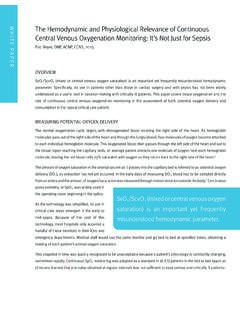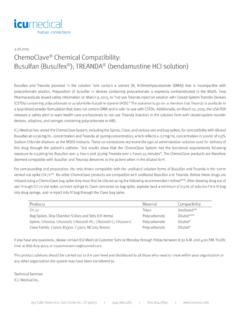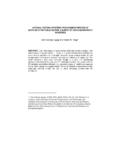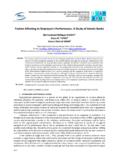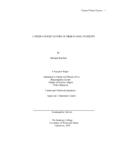Transcription of Using continuous SvO 2 to assess oxygen …
1 Using continuous SvO2 to assess oxygen supply/ demand balance STUDY SUMMARY. in the critically ill patient Kathleen M. White, RN, MS, CCRN. PURPOSE. Patients in critical care are often monitored to alert caregivers to threats of hemodynamic stability (as measured by blood pressure, cardiac output, pulmonary capillary wedge pressure, central venous pressure, and systemic vascular resistance) and the adequacy of oxygenation (arterial oxygen tension and arterial oxygen saturation). However, none of these variables describe the ultimate purpose of the cardiopulmonary system to deliver sufficient amounts of oxygen to satisfy tissue demands. This summary reviews how oxygen supply is threatened and how it can be assessed in individual patients. The determinants of oxygen delivery are discussed; the conditions that affect oxygen demand and how decreases in mixed venous oxygen saturation (SvO2) can reflect the supply/ demand imbalance. Decreases in SvO2 can serve as an early warning of cardiopulmonary inadequacy, often long before hemodynamic instability occurs.
2 Activities and conditions that increase tissue demand for oxygen help clinicians identify those patients whose oxygen demands should be controlled. Additionally, conditions that prevent tissue extraction of sufficient amounts of oxygen and increase SvO2 are explained. oxygen DELIVERY, demand , AND SvO2. Many critical care patients are unable to increase oxygen supply to match increased demand caused by events such as shivering, fever, physical agitation, or seizures. The most vulnerable patients are those whose supply system is incapable of meeting oxygen demands even in the resting state. When delivery is insufficient, the tissues extract more oxygen , resulting in slowed movement of oxygen into the Cell consumption of oxygen cannot meet cell demand , and oxygen debt, anaerobic metabolism, and lactic acidosis result, causing death if untreated or , 3. continuous SvO2 MONITORING TECHNOLOGY. The monitoring of SvO2 can be used to track threats to oxygen supply/ demand balance and to guide treatment that supports sufficient oxygenation of tissue.
3 Introduced in 1981, the Opticath (now sold and marketed as TriOx from ICU Medical, Inc.). pulmonary artery (PA) catheter with fiber optics enables continuous monitoring of oxygen saturation of mixed venous blood. CLINICAL APPLICATIONS: SvO2 AS A REFLECTION OF DECREASED DELIVERY. SvO2 monitoring is used in critically ill patients with respiratory failure to track: >> SaO2 and the adequacy of other delivery factors, such as CO and Hemoglobin (Hgb). >> Extent to which oxygen consumption has been increased by work of breathing, fever, agitation, and other factors known to increase demands >> oxygen supply/ demand status prior to and after suctioning 4. >> Ventilator weaning, as a decrease in SvO2 implies a deterioration in SaO2/PaO2 or an increase in work of breathing 5. >> Assessment of ventilation after a position change, chest tube insertion, thoracentesis, or any change in ventilator settings or oxygen administration Another clinical application is with the patient with decreased Hgb, as this threatens the delivery of oxygen to , 7.
4 Decreased SvO2 was found to be a more reliable indicator of occult bleeding than was change in heart rate, pulse pressure, central venous pressure, or pulmonary capillary wedge pressure. Probably the most serious threat to oxygen supply in critical illness is any condition that decreases In patients with cardiac compromise, monitoring for any decrease in SvO2 can help determine the severity of the oxygen supply/ demand balance and to guide the effectiveness of therapy designed to increase CO. SVO2 AS A REFLECTION OF INCREASED oxygen DEMANDS. An oxygen supply that may be adequate at rest will not be adequate if the need for oxygen is increased, which may occur during routine nursing care activities such as turning, bathing, or linen changes. SvO2 monitoring can help pace nursing care according to the tolerance of the patient. CONDITIONS THAT INCREASE SVO2. Increased SvO2 is associated with several dysfunctions in oxygen transport such as the presence of intracardiac shunts.
5 Some cardiologists use continuous SvO2 monitoring to reduce venous blood gas sampling time and costs. Also, cyanide toxicity inhibits oxygen processing by the mitochondria, which results in an increased SvO2. A major cause of abnormal transport and cellular use of oxygen is the septic syndrome, in which reduced oxygen consumption by active organs can result from maldistributions in blood Some studies have shown that increased SvO2 and decreased VO2 are early indicators of the onset of the septic ,11,12. SUMMARY. Assessment of hemodynamic and pulmonary function Using PA catheters and arterial blood gas analysis has become standard in the care of the critically ill. However, the data provided focus on the status of the supply of oxygen , but not on how well the supply is meeting the demand of the tissues. continuous SvO2 monitoring provides ongoing assessment of the oxygen supply/ demand imbalance and may be used to initiate efforts to improve supply or control demand to reverse any imbalances that threaten the stability of the patient.
6 To ensure that tissues are well-oxygenated, oxygen supply and demand are new targets of therapy for the critically ill patient. Summarized from the study originally published in the journal American Association of Critical-Care Nurses (AACN) Clinical Issues in February 1993. References 1. McGee WT, Veremakis C, Wilson GL. Clinical importance of tissue oxygenation and use of the mixed venous blood gas. Res Medica 1988; 4:15-24. 2. Kandel G, Aberman A. Mixed venous oxygen saturation: Its role in the assessment of the critically ill patient. Arch Intern Med 1983; 143:1400-1402. 3. Aberman A. Fundamentals of oxygen transport physiology in a hemodynamic monitoring context. In Schweiss JF, ed. continuous Measurement of Blood oxygen Saturation in the High Risk Patient. San Diego: Beach International; 1983:13-26. 4. Walsh JM, Vanderwarf C, Hoschlet D, et al. Unsuspected hemodynamic alterations during endotracheal suctioning. Chest 1989; 95:162-165. 5. Harpin RP, Baker JP, Downer JP, et al.
7 Correlation of the oxygen cost of breathing and length of weaning from mechanical ventilation. Crit Care Med 1987; 15:807-812. 6. Bryan-Brown CW, Gutierrez G. Gas transport and delivery. In Shoemaker WC, ed. Textbook of Critical Care. Philadelphia: WB Saunders; 1989:491-500. 7. Kazarian KK, Del Guercio IRM. The use of mixed venous blood gas determinations in traumatic shock. Annals of Emergency Medicine. 1980; 9:179-182. 8. Jamieson WRE, Turnbull KW, Larrien AJ, et al. continuous monitoring of mixed venous oxygen saturation in cardiac surgery. Can J Surg 1982; 25:538-543. 9. Clark AP, Winslow EH, Tyler DO, White KM. Effects of endotracheal suctioning on mixed venous oxygen saturation and heart rate in critically ill adults. Heart Lung 1990; 19:552-557. 10. Divertie MG, McMichan JC. continuous monitoring of mixed oxygen venous saturation. Chest 1984; 85:423-428. 11. Gore JM, Sloan K. Use of continuous monitoring of mixed venous saturation in the coronary care unit.
8 Chest 1984; 86:757-761. 12. Bartlett RH, Dechert RE, Mault JR, Clark SF. Metabolic studies in chest trauma. J Thorac Cardiovas Surg 1984; 87:503-508. 2012 ICU Medical Inc. M1-1347 Rev. 01.
